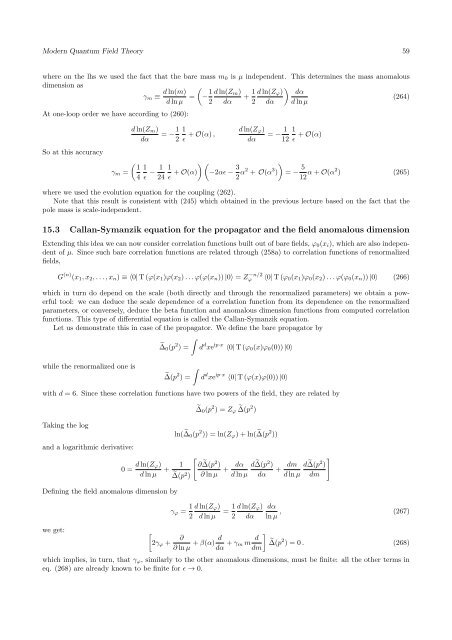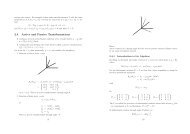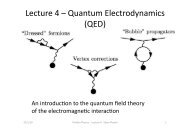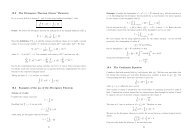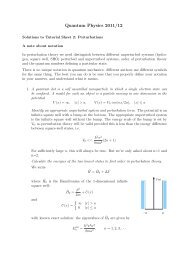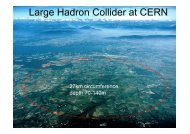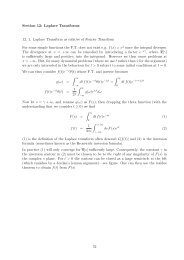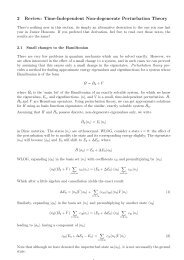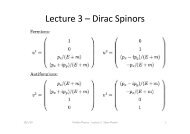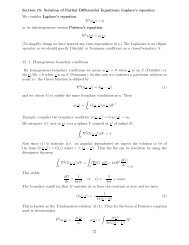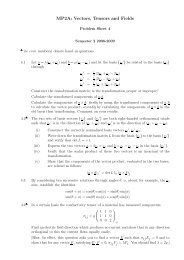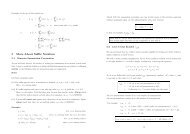15 The renormalization Group
15 The renormalization Group
15 The renormalization Group
You also want an ePaper? Increase the reach of your titles
YUMPU automatically turns print PDFs into web optimized ePapers that Google loves.
Modern Quantum Field <strong>The</strong>ory 59where on the lhs we used the fact that the bare mass m 0 is µ independent. This determines the mass anomalousdimension asγ m ≡ d ln(m) −d ln µ = 1 d ln(Z m )+ 1 d ln(Z ϕ ) dα(264)2 dα 2 dα d ln µAt one-loop order we have according to (260):So at this accuracy 1γ m =4d ln(Z m )dα= − 1 21 + O(α) , d ln(Z ϕ )= − 1 1dα 12 + O(α)1 − 1 124 + O(α) −2α − 3 2 α2 + O(α 3 ) = − 5 12 α + O(α2 ) (265)where we used the evolution equation for the coupling (262).Note that this result is consistent with (245) which obtained in the previous lecture based on the fact that thepole mass is scale-independent.<strong>15</strong>.3 Callan-Symanzik equation for the propagator and the field anomalous dimensionExtending this idea we can now consider correlation functions built out of bare fields, ϕ 0 (x i ), which are also independentof µ. Since such bare correlation functions are related through (258a) to correlation functions of renormalizedfields,G (n) (x 1 ,x 2 ,...,x n ) ≡0| T(ϕ(x 1 )ϕ(x 2 ) ...ϕ(ϕ(x n )) |0 = Z −n/2ϕ 0| T(ϕ 0 (x 1 )ϕ 0 (x 2 ) ...ϕ(ϕ 0 (x n )) |0 (266)which in turn do depend on the scale (both directly and through the renormalized parameters) we obtain a powerfultool: we can deduce the scale dependence of a correlation function from its dependence on the renormalizedparameters, or conversely, deduce the beta function and anomalous dimension functions from computed correlationfunctions. This type of differential equation is called the Callan-Symanzik equation.Let us demonstrate this in case of the propagator. We define the bare propagator by∆ 0 (p 2 )= d d xe ip·x 0| T(ϕ 0 (x)ϕ 0 (0)) |0while the renormalized one is∆(p 2 )=d d xe ip·x 0| T(ϕ(x)ϕ(0)) |0with d = 6. Since these correlation functions have two powers of the field, they are related byTaking the logand a logarithmic derivative:0= d ln(Z ϕ)d ln µ + 1∆(p 2 )Defining the field anomalous dimension bywe get:∆ 0 (p 2 )=Z ϕ ∆(p 2 )ln( ∆ 0 (p 2 )) = ln(Z ϕ )+ln( ∆(p 2 ))∂ ∆(p 2 )∂ ln µ +dα d∆(p 2 )+ dmd ln µ dα d ln µd∆(p 2 )dmγ ϕ = 1 d ln(Z ϕ )2 d ln µ = 1 d ln(Z ϕ ) dα2 dα ln µ , (267)2γ ϕ +∂∂ ln µ + β(α) ddα + γ m m d dm∆(p 2 )=0. (268)which implies, in turn, that γ ϕ , similarly to the other anomalous dimensions, must be finite: all the other terms ineq. (268) are already known to be finite for → 0.


